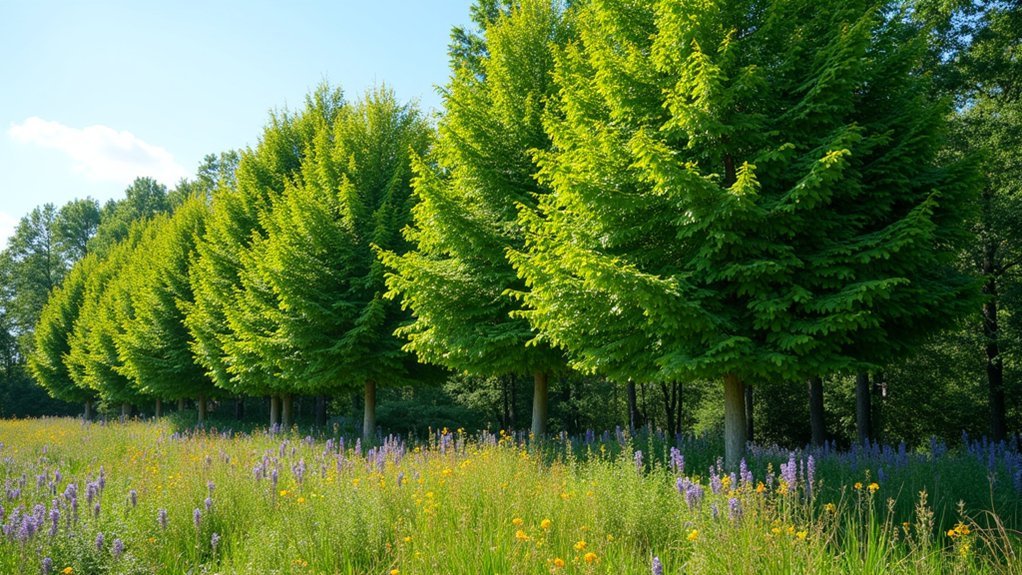Plant windbreaks that double as pollinator havens by selecting native trees like lindens, redbuds, and maples for nectar sources. Space trees about 20 feet apart in multiple rows, with tall evergreens on the windward side and flowering species in inner rows. Create year-round blooming sequences by combining early spring varieties with summer and fall bloomers. This strategic arrangement not only shields your property from wind but transforms your landscape into a thriving ecosystem for essential pollinators.
Dual-Purpose Windbreak Species for Pollinator Support

While traditional windbreaks primarily serve to reduce wind velocity across farmland, selecting the right tree species can transform these protective barriers into valuable pollinator habitats.
Consider planting Lindens and Redbuds, which not only block wind effectively but provide abundant nectar and pollen for pollinators in spring.
Maples deserve special attention in your windbreak design—their early-season pollen supports bees emerging from winter dormancy when food sources are limited.
For summer blooms when other resources may be scarce, integrate Sumac species to maintain pollinator activity throughout the growing season.
Tuliptrees offer impressive wind protection while attracting pollinators with large, fragrant flowers.
Whenever possible, prioritize native plants in your windbreak. These species support local pollinators most effectively while enhancing your agricultural landscape’s overall resilience.
Strategic Arrangement of Trees for Maximum Wind Protection
When designing your windbreak, proper tree arrangement becomes as essential as species selection for effective wind protection.
Create approximately 100-foot thick barriers with trees for pollinators arranged in multiple rows, spacing them about 20 feet apart to guarantee density while providing food for multiple species of bees and other beneficial insects.
- Position your tallest evergreens on the windward side (typically northwest) to effectively deflect approaching winds.
- Integrate flowering deciduous trees like redbuds in inner rows to create a diverse, multi-layered habitat.
- Add shrubs throughout your design to enhance protection while offering additional foraging opportunities.
This strategic arrangement not only maximizes wind protection for your property but creates an ecological haven where multiple species can thrive, even during challenging weather conditions.
Year-Round Blooming Sequence for Continuous Nectar Supply

To support pollinators throughout the seasons, creating a thoughtful blooming sequence in your windbreak is essential. Start with early spring varieties like redbuds and maples that provide significant nectar for emerging bumblebee queens establishing their colonies.
As spring shifts to summer, different species such as linden trees and sumacs offer abundant resources when other flowering plants may be scarce. These trees provide essential sustenance for diverse bees and butterflies during peak activity periods.
Don’t overlook fall-blooming options like certain dogwoods, which support pollinators preparing for winter.
By selecting trees with staggered flowering times, you’ll create a continuous nectar buffet that maintains healthy pollinator populations year-round.
A well-designed windbreak with sequential blooming not only blocks wind but becomes a thriving ecosystem that benefits your garden and local biodiversity.
Creating Wildlife Corridors With Multi-Layer Windbreaks
Multi-layer windbreaks extend beyond sequential blooming by creating vital wildlife corridors that connect fragmented habitats across landscapes.
When you plant a wide variety of trees and shrubs in multiple layers, you’re establishing highways for Bees and Other Pollinators to travel safely between feeding grounds, especially in rural areas where natural habitats may be disconnected.
These living corridors offer three significant benefits:
- Microclimate protection that shields pollinators from harsh winds and extreme weather
- Year-round habitat that supports diverse wildlife through all life stages
- Genetic diversity maintenance as different pollinator populations can intermix
Pesticide-Safe Windbreak Designs for Pollinator Health

Although modern agriculture often relies on pesticides, strategic windbreak designs can greatly reduce chemical exposure to pollinators while enhancing farm productivity.
Select appropriate tree species like dioecious males or non-flowering conifers that naturally deter pests without attracting beneficial insects during spray periods.
Large trees positioned strategically create effective barriers against pesticide drift, protecting flowering plants where pollinators feed.
Time your applications during minimal wind conditions and avoid spraying when clusters of flowers are in bloom on your windbreak plants.
Native species offer dual benefits—they support diverse pollinator populations while reducing energy costs through improved microclimate regulation.
Frequently Asked Questions
What Is the Best Tree to Plant for a Windbreak?
For windbreaks, you’ll want maples or lindens that stand strong against wind. They’re sturdy, reliable choices that establish well. Consider redbuds or tuliptrees too if you’re looking for additional landscape benefits.
What Trees Do Bees Love the Most?
Bees particularly love lindens for their abundant nectar, maples for early-season pollen, redbuds for spring blooms, sumacs for summer feeding, and catalpas for their large nectar-rich flowers. You’ll attract various bee species with these trees.
What Is the Best Pollinator Tree?
Lindens are your best pollinator tree choice. You’ll attract abundant bees with their nectar-rich flowers. Maples provide essential early-season pollen, while redbuds, tuliptrees, and sumacs extend your garden’s pollinator support throughout seasons.
What Is the Most Effective Windbreak?
The most effective windbreak combines tiered vegetation: dense shrubs, small deciduous trees, and alternating evergreens with at least 100 feet thickness and 20-foot row spacing. You’ll get maximum wind protection with this diverse structure.
In Summary
By planting dual-purpose windbreak trees, you’re creating powerful protection for your property while supporting essential pollinators. Arrange your species strategically, ensuring year-round blooms and creating crucial wildlife corridors. Remember to implement pesticide-safe designs that won’t harm your buzzing visitors. Your thoughtful windbreak won’t just reduce wind damage—it’ll become a thriving ecosystem that connects fragmented habitats and helps sustain our declining pollinator populations.





Leave a Reply